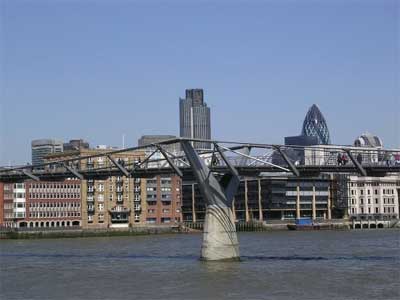Steve Strogatz has always been intrigued by the phenomenon of resonance. Therefore, when this professor of applied mechanics and theory at Cornell University learned that thousands of pedestrians had caused the Millennium Bridge in London to sway back and forth on its opening day, he took notice.
Before the bridge, which spans the River Thames, was inaugurated, designers hailed it as “a fundamental model of construction.” Engineers referred to it as “a perfect message about our capabilities at the threshold of the 21st century.”
 |
|
Millennium Bridge in London. |
However, the events that unfolded on the bridge’s opening day became the subject of Strogatz’s article.
The Millennium Bridge, a 320-meter suspension bridge, connects London’s financial district to Bankside, on the south bank of the Thames, and was inaugurated on June 10, 2000. Thousands of pedestrians flocked to the new structure.
At first, the bridge stood still. But then it began to sway, very lightly. Almost immediately after, the swaying intensified. Suddenly, the pedestrians walking became akin to ice skaters testing their balance, spreading their legs wide and shifting their weight with each step. Left, right, left, right, almost perfectly synchronized.
The resonance was nearly unconscious. Yet these unintentional steps, Strogatz noted, turned a $32 million achievement into a ridiculous spectacle. The bridge was closed almost immediately.
Strogatz explained that the issue lay in both the crowd effect and the bridge’s architecture.
The Millennium Bridge exceeded standards for heavy load capacity and wind resistance. Additionally, all non-human factors had been tested. However, instead of focusing on the structure, Strogatz examined the strange phenomenon of how people unintentionally collaborated simply by walking.
For years, it has been known that a marching military unit crossing a bridge can generate vertical resonance strong enough to destroy it. Therefore, the mandatory standard for soldiers is not to march in step when crossing any bridge.
However, the issue with the Millennium Bridge was not entirely the same. Strogatz noted that in this case, the oscillation was horizontal, rather than vertical. More importantly, only pedestrians were on the bridge. No one was trying to walk in unison; they were merely adapting to the strange vibrations underfoot.
But what came first, the oscillation of the bridge or the resonating footsteps? And what triggered the system initially?
“That’s the chicken-and-egg problem: which came first,” Strogatz remarked. From the outset, the bridge had two factors working against it: it was designed as a flexible structure, and its natural frequency coincided with the human walking pace. Thus, even a relatively small group of people crossing could trigger the swaying phenomenon.
“If people initially walked freely and randomly, a few of them would coincidentally resonate their footsteps, causing the bridge to become unstable,” he explained. With a critical mass of pedestrians, the swaying would become strong enough to force everyone to step in unison, worsening the problem.
This critical mass of pedestrians—later tested on the Millennium Bridge, as analyzed independently by Strogatz and his colleagues—was just 160. While it was estimated that up to 80,000 people crossed the bridge on its opening day, at any given moment, there could be up to 2,000 people on it.
“I’m not a structural engineer. I know nothing about bridges” – Strogatz said – “what I know is the crowd effect.”
The Millennium Bridge reopened in 2002 after engineers installed 91 dampers to absorb both horizontal and vertical vibrations. This repair cost approximately $8.9 million.
If Strogatz’s analysis is correct – “and we hope someone will verify it,” he said – engineers could use it to prevent such costly and potentially dangerous failures from occurring in the first place. “They could address the issue before building it,” Strogatz concluded.
T. An (according to Physorg)



















































